Potato diseases – and there are a multitude of pests. Very often, however, problems can be avoided with a varied crop rotation.
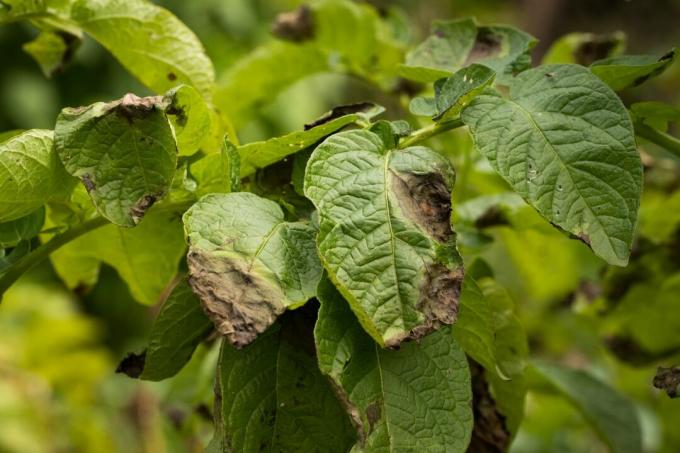
The potato (Solanum tumberosum) can be attacked by many different pathogens. In particular, the reproduction of the nutritious tubers on the same area favors the infestation and the spread of the pathogens via the soil or tubers remaining in the bed. Before and after planting potatoes Therefore, a break in cultivation of 4 – 5 years should always be observed. In this article we give an overview of the most important potato diseases and pests, as well as prevention and control strategies.
contents
-
Potato diseases at a glance
- Bacterial potato diseases
- fungal diseases in potatoes
- viral diseases
- Common potato pests
Potato diseases at a glance
Below you will find the main potato diseases, their causative agents, symptoms and measures to combat them. We only give a brief overview of rare diseases, as they are of little importance in hobby cultivation.
Bacterial potato diseases
Bacteria mainly cause weeping, rotting spots on potatoes. This often makes the tubers completely inedible. For bacterial diseases, the main vector is an infected tuber, so the best avoidance strategy is to purchase certified, healthy seedlings.
- Stem and tuber wet rot(Pectobacterium carotovorum and Dickeya): Bacterial wilt is also known as blackleg. From the middle of June, affected potato plants wither and roll up their leaves. The bacterium blocks the water channels and causes wet rot on the blackened stalk, making it easy to pull the shoots out of the ground. The inside of the stalk is mushy and slimy. Tubers damaged at harvest develop wet rot in storage. They become soft and mushy and are separated from the healthy tissue by a black line. Direct combat is not possible. As a preventive measure, only use designated seed potatoes, do not set tubers too early or too late, and remove infested plants and tubers. After careful harvesting, allow to dry and check regularly in storage.

Other bacterioses of potatoes are:
- ring rot (Clavibacter michiganensis subsp. sepedonicus): Unspecific symptoms such as wilt, chlorosis or curling of leaves develop on the potato plant. Bacterial ring rot can only be clearly identified by looking at the cut tubers. Here, a few millimeters below the shell, there is a brown discoloration of the conduction pathways. Such tubers are often attacked by other pathogens and rot. Ring rot is a quarantine disease that must be reported!
- mucous disease (Ralstonia solanacearum): Here, too, non-specific symptoms of the disease appear on the plant, but in the tuber, a whitish bacterial slime emerges from also browned channels. Slime disease is a quarantine disease that must be reported!
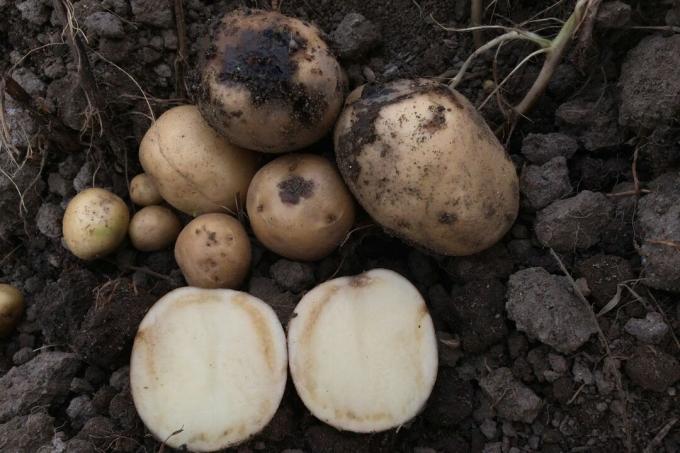
fungal diseases in potatoes
Fungi cause many different diseases in potatoes. The best way to combat this is prevention. With some diseases, however, no plant protection measures help when the symptoms appear.
Prevent fungal diseases on potatoes:
- Choose less susceptible varieties
- Remove overgrown potatoes early from the previous year
- Pre-germinate tubers for an earlier harvest before infestation
- Choose wide row and plant spacing for good drying
- Apply balanced fertilization
- Harvest only mature tubers with firm skin
- Against soil-borne fungi: extensive crop rotation; Use of healthy seedlings
- In the event of an acute infestation: dispose of infected plant tissue in household waste; approved sprays
The following fungal diseases are important in hobby cultivation:
- Colletotrichum wilt(Colletotrichum coccodes): Soil-borne fungus, which causes entire shoots to die off, especially in hot and dry years. The leaves wither, soon turn brown and dry up on the stem, which is often still green. Small black dots appear at the base of the stem, the roots appear brittle and rotten. The tubers can also be affected.
- potato scab(Streptomyces scabies): The ray fungus occurs naturally in the soil and infects the potato tuber from June to July, preferably on dry, calcareous soils. When infested, the tubers show a corky-pocked surface with partly net-like cracks, but no spore formation. Potato scab is only visually significant, as it does not affect taste or yield. You can easily prevent potato scab by planting resistant varieties. In addition, soil life can be promoted as competition with the pathogen. Liming the soil before planting the potatoes should be avoided.

- late blight(Phytophthora infestans): Also known as potato blight, the disease is transmitted by an egg fungus (oomycete) overwintering in infected tubers in the field. Depending on the weather, the first symptoms appear from the end of June. Yellowish, soon darkened spots form on the potato leaves, and gray-white fungal growth appears on the underside of the leaves. Over time, the entire plant is affected and dies. The tubers show sunken, grey-blue, hard spots; under the shell the tissue is hard and discolored dark brown.
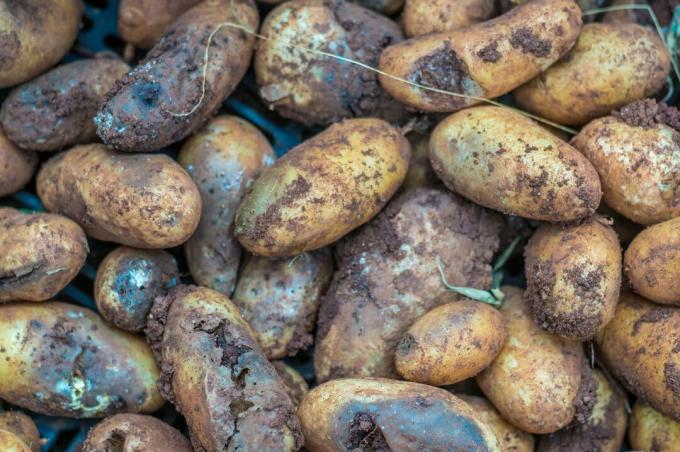
- powder scab(Spongospora subterranea): Fungal disease especially in damp and cool weather and at higher altitudes. Dark, warty bumps and elevations appear on the tubers, which later rupture and release black spores. In the home garden, powdery scab spreads via potato skins on the compost or tubers left in the ground from the previous year. Infested tubers and their remains should therefore be disposed of with household waste. A wide crop rotation, less susceptible varieties and healthy seedlings are the best control methods.
- dry rot or white rot (Fusarium): Storage disease in which white fungal mycelium forms on the tubers and underneath deep, dry rots. The pathogens penetrate the potatoes through injuries during the harvest or from adhering remains of soil.

- root killer disease or beet rot(Rhizoctoniasolani): Potato disease that causes dark, superficial spots on the tubers and sunken, brown spots on the stalk. The plants grow stunted and form only a few shoots. A whitish fungus coating ("white thorns") can form on the base of the stem, sometimes the leaves at the shoot tip curl up ("top curls"). The pathogen is soil-borne, only changing the area and a wide crop rotation prevent renewed infestation.
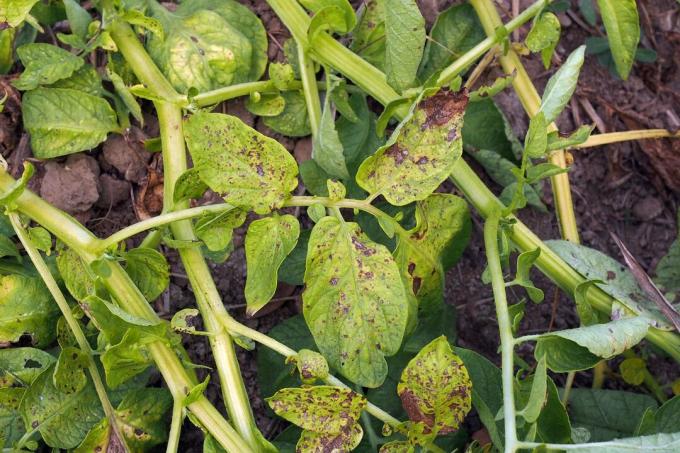
Other fungal diseases of potatoes are:
- early blight (Alternaria solani): fungal disease mainly at late potatoes. From June, sharply demarcated, round, brown spots that can break out appear on the older leaves. Demarcated, sunken, brownish areas with firm tissue appear on the tuber.
- gray mold (Botrytis cinerea): This fungal disease causes greyish spots on dead leaf tissue, especially after a dry spell in cool, damp weather. It does not need to be treated on potatoes as it will go away on its own in drier weather.
- potato crab (Synchytrium endobiotic): Notifiable quarantine disease caused by a soil-borne fungus. Bulbous, cauliflower-like growths appear on the tubers and sometimes on the stems, which later rot and fall apart.
- stem rot (Sclerotinia sclerotiorum): Disease that is more widespread in northern Germany, in which the mycelium of the fungus covers parts of the stalk. In addition, dark, round outlasting structures, the sclerotia, can be seen. The affected stems easily bend over in wind or thunderstorms.
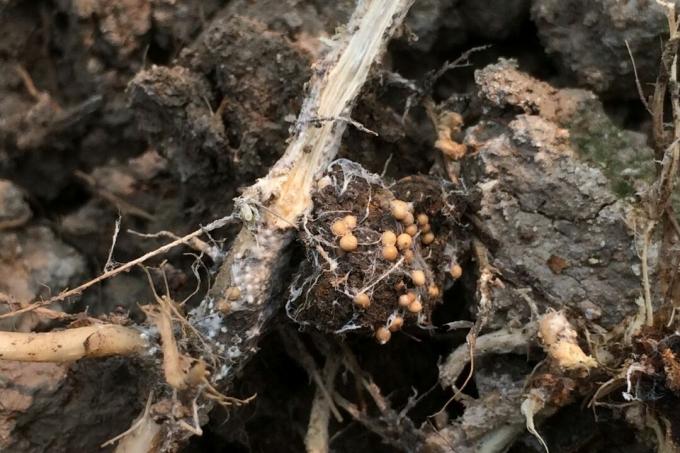
viral diseases
Viruses on potatoes are mainly transmitted via sucking pests, above all aphids (Aphidoideae) and some phytotoxic nematodes (Trichodorus and Paratrichodorus) transfer. They cause growth disorders, often also leaf symptoms and yield losses of between 10 - 80%. Resistant varieties, certified planting material and a wide crop rotation are helpful measures before planting. Also about mechanical injuries, when piling up, chopping, etc. viruses can be transmitted. Affected plants should be carefully removed, but their tubers are safe to eat.
- leaf roll disease(Potato Leaf Roll Virus PLRV): Viral disease with typically upturned leaflets and yellow discoloration. The plants are significantly smaller and have a steep leaf position, the foliage is rigid and rustling. Yield losses of up to 80% are possible.
- iron stain(Tobacco Rattle Virus TRV): Potato disease iron spot is transmitted by free-living nematodes previously attached to infected weeds such as Chickweed (Stellaria media) or shepherd's purse (Capsella bursa–pastoris) sucked. The often compressed shoots rarely show symptoms on the leaves and the yield hardly suffers. However, black-grey spots and sunken rings are visible in tubers that have been cut open.
- tobacco rib tan(potato Y virus): The world's most important potato virus causes dark brown, necrotic speckles on the underside of the leaf and a slight mosaic chlorosis. The leaves can die off completely, the tubers are sometimes affected and show dark spots, which, however, do not penetrate particularly deeply in comparison to iron spot.

Soil-borne pathogens can make potato cultivation in one area unprofitable for years. A real alternative is cultivation in a pot, because most pests have no access here. Our Plantura organic tomato and vegetable soil is also suitable for potato culture. It has a high compost content, is additionally pre-fertilized and provides important nutrients for the first few weeks after planting.
Common potato pests
Various pests cause signs of feeding on potatoes, sometimes only on the plant, but often also on the tasty tubers. We present the most common potato pests and give tips on how to avoid and control them.
- aphids (Aphidoideae): The small, sucking insects can cause deformation of the leaves on potatoes. In the wild, however, the small insects are quickly taken over by beneficial insects such as ladybug (coccinellidae), lacewing larva (Chrysoperla carnea) and Co. decimated and kept in check.
- wireworms (Agriotes): The deep yellow beetle larvae, a few millimeters long, eat deep tunnels in the nutritious tubers. Wireworm infestations on potatoes can be prevented with tillage, early harvest (early variety and pre-germination) as well as a balanced crop rotation with a break in cultivation of 4 - 5 years to reduce.
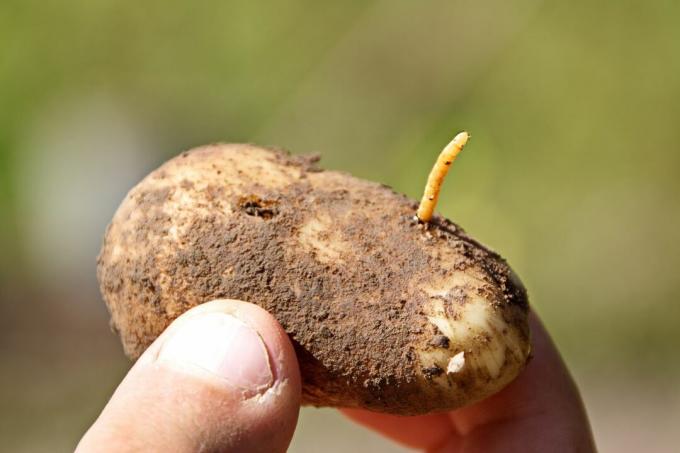
- cutworms (agrotis): The caterpillars of moths prefer to live in light, warm soil and can cause serious damage to the potato tubers. The grey-brown, shiny caterpillars, up to 5 cm long, curl up when touched. The moths also lay their eggs on weeds, so hoeing the potato rows is an important preventive measure. An acute infestation of cutworms on potatoes can be caused by nematodes of the genus Steinernema capsicae be fought, which are simply stirred in water and distributed with the watering can. For example ours Plantura SC nematodes you can use for this.
- Colorado potato beetle (Leptinotarsa decemlineata): The beetle overwinters in the ground and lays its eggs on the underside of leaves shortly after the first potato sprouts appear. The larvae of the Colorado potato beetle eat up entire potato plants within two to three weeks. The oil of neem tree (Azadirachta indica), for example in the form of ours Plantura Pest Free Neem, can be injected against the Colorado potato beetle larvae in the young larval stages L1 – L3. A daily check of the plants is therefore particularly important in order not to miss the sensitive stages. Colorado potato beetles and their larvae can be collected when they are already too large for a neem treatment.
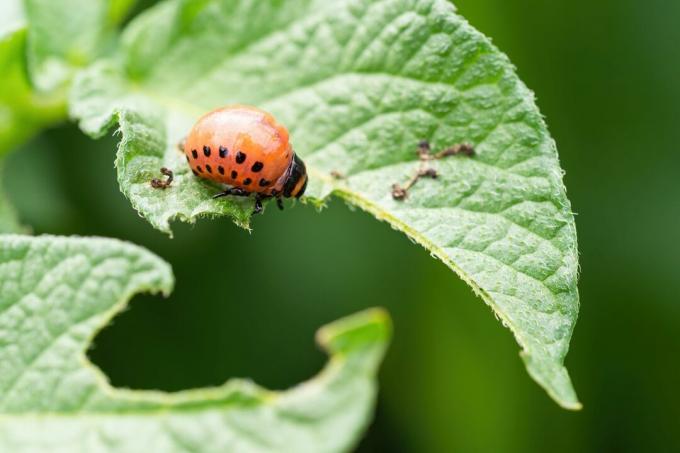
- Cyst-forming potato nematodes(globodera): If potatoes are planted too few years apart, they can harmful nematodes settle and repeatedly infest the roots of the plants. A severe infestation is reflected in growth disorders and yellowing of the leaves. Small, brownish cysts appear on the roots, which can survive in the soil for up to 15 years. The potato plant yields up to 50% less. Wide crop rotation without other host plants and resistant varieties prevent nematode infestation.
- voles(Arvicolinae): Different types of Arvicolinae, especially the field mouse (Microtus arvalis) gnaw at the potato tubers and can cause great damage. Above ground, individual shoots can wither and die because their roots have been cut. In our special article you can read all about the rodents and how you expel voles be able.
Many potato diseases can be prevented or limited by good crop rotation and mixed cultures instead of monocultures. We give tips on what to do with the Mixed culture of potatoes should be considered and which plant neighbors are suitable.

